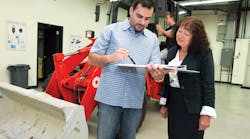Modern on-road vehicles have been making steady strides when it comes to employing technological advances featuring active safety systems. However, similar technology for off-highway machines has lagged behind.
Steering systems have been receiving a lot of attention in the automotive sector, where several electric and electrohydraulic steering architectures have been implemented and steer-by-wire technologies undergo extensive research and development. Off-highway articulated steering vehicles, on the other hand, have not adequately evolved to meet the needs of original equipment manufacturers and their end customers.
Many of today’s hydrostatic steering systems exhibit poor energy efficiency due to valve throttling losses and are considered passive systems relative to safety, adjustability, and comfort. A paper by Naseem Daher, with the MAHA Fluid Power Research and Education Center, Purdue University, introduces an unconventional method of electrohydraulic power steering that uses pump-displacement control, a proven energy-saving technology.
The pump-controlled method eliminates throttling losses associated with hydraulic control valves by controlling the displacement of a variable-displacement pump. This new architecture lends itself to high-energy efficiency, resulting in lower fuel consumption and reduced emissions, higher machine productivity and reduced operator fatigue, and active safety functions that counteract instabilities and reject disturbances.
For more information, see the in-depth news story posted to our Web site at bit.ly/1bAKvnm.


